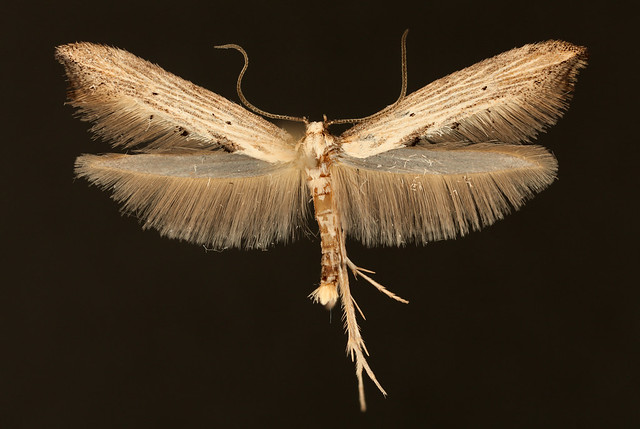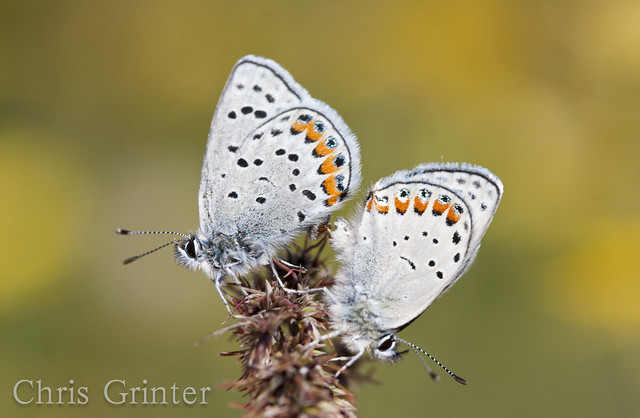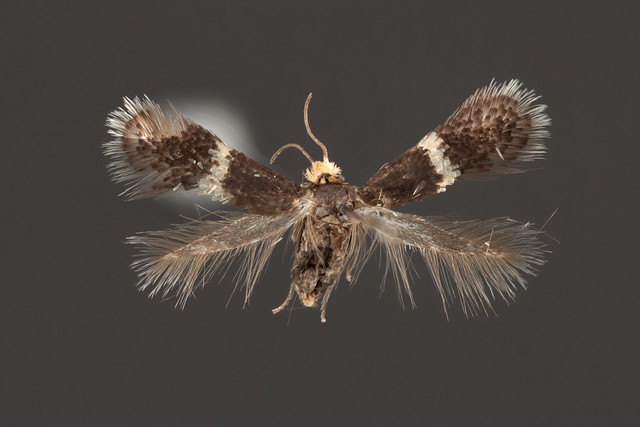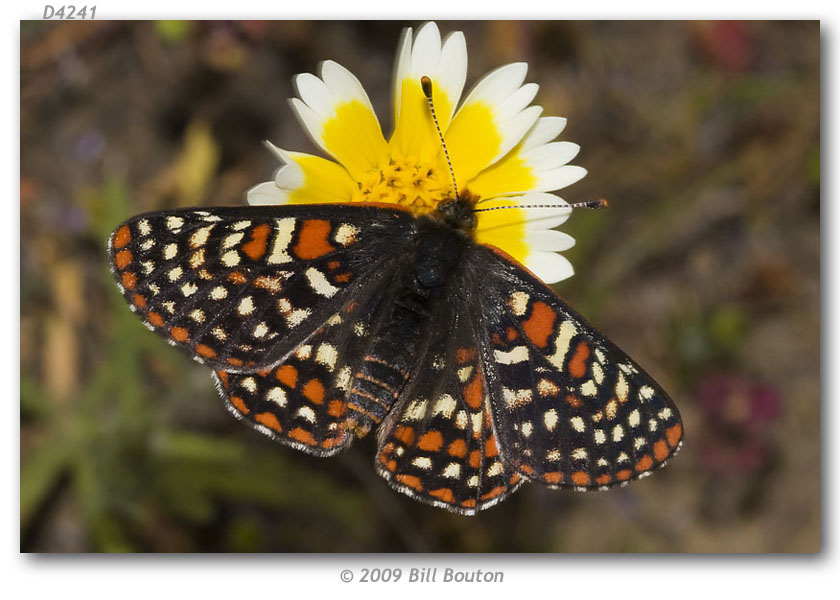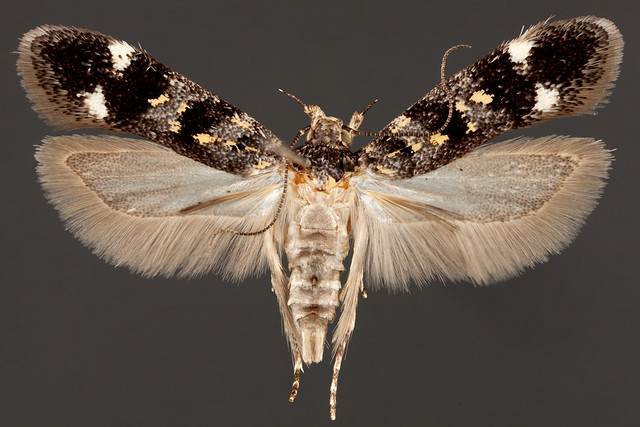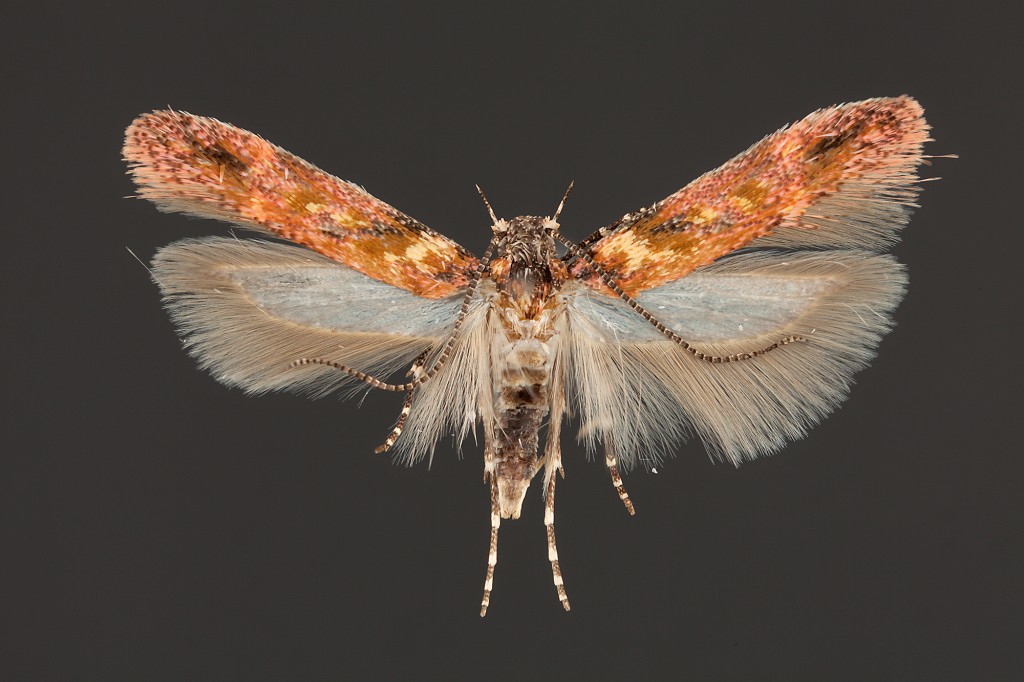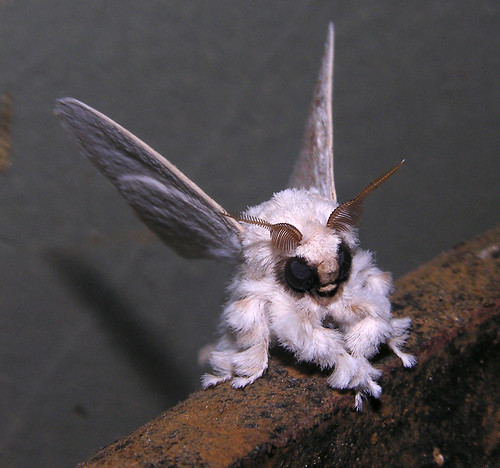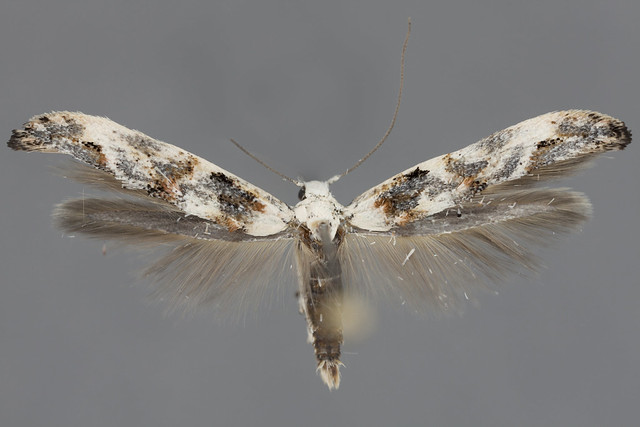הייַנט ס מאָל איז אַ שיין מינים פון די ראַקי בערג אַרויס פון דענווער, עפּערמעניאַ סטאָלידאָטאַ (עפּערמעניידאַע). דאס איז פאקטיש אַ גרעסערע ספּעסאַמאַן ווי עס אויס, וועגן 20מם פון ווינגטיפּ צו ווינגטיפּ. יענע אויפשטיין, פינצטער, טאַפץ פון וואָג אויף די שפּעטערדיק ברעג פון דער פאָרווינג איז אַ גרויס כאַראַקטער פֿאַר דעם משפּחה, ווי ווויל ווי דער נודניק בריסאַלז אויף די הינד טיביאַ (אויך עפּעס קענטיק דאָ). עס זענען 11 מינים אין 2 גענעראַ אין די פאַרייניקטע שטאַטן, מיט מסתּמא אַ ביסל מער צו זייַן דיסקאַווערד. יונגערמאַן קיוראַטאָריאַל אַסיסטאַנט דוד בעטמאַן קיד דעם מינים אויס ניצן דער רעוויזיע פון דער נעאַרקטיק מינים: פּדף דאָ.
|
דאס וואָך איך בין ייַנטיילונג אַ קליינטשיק, סקראַפי, און האַלב-קאַמפּאַטינטלי פאַרשפּרייטן נעפּטיקולידאַע אין די מין סטיג מעלאַ פון די זעלבע ליכט טראַפּ פון פּרעסקאָטט אַריזאָנאַ ווי דער פאַרגאַנגענהייַט ביסל מאנטיק מאָטס. איך יוזשאַוואַלי וואָלט ניט שער אַ פאָטאָ פון אַ מאָל וואָס איז נישט אין דער בעסטער צושטאַנד, אָבער איך בין ניצן דאָס ווי אַ בייַשפּיל פון טעכניק. נישט בלויז איז געווען דעם 4מם מאָל פּולד אויס פון די דנאָ פון אַ ליכט טראַפּ, אָבער עס איז געווען פעלד פּינד און דאַר פֿאַר איבער אַ יאָר און אַ האַלב. איך ווע שטענדיק געהערט אַז עס קענען קימאַט זייַן אוממעגלעך צו האַנדלען מיט די קלענסטער פון דעם קליין; און פֿאַר די רובֿ טייל איך האָבן נישט. איך געניצט צו טראַכטן איר דאַרפֿן צו כאַפּן זיי אַוועק פון אַ ליכט בויגן לעבעדיק אין אַ וויאַל און יוטאַנייז מאָומאַנץ איידער פארשפרייטן, אַלע בשעת קיינמאָל, אלץ לאָזן זיי טרוקן די טייניאַסט ביסל פארויס. אבער ווי עס טורנס אויס, איר קענען באַקומען אַוועק מיט אַ לייַטיש ספּעסאַמאַן דורך רילאַקסינג 24 שעה און פארשפרייטן קאַפּויער. פון קורס אויב איר האָבן אַ בישליימעס פריש ספּעסאַמאַן אַז אַוווידיד די בלענדער פון אַ עמער-טראַפּ עס וואָלט מאַכן פֿאַר אַ ווייַט העכער ספּעסאַמאַן. בעסער נאָך, איר פּולד דעם בלאַט מייַן און רירד די מאָל זיך. רובֿ פון די נעפּטיקולידאַע ביסט באַלעבאָס-ספּעציפיש און ווייַט מער דייווערס ווי מיר האָבן געגעבן זיי קרעדיט. איך ווע געהערט עס קען זייַן בייַ מינדסטער 100 נייַ מינים אַווייטינג אנטדעקונג אין די יו. עס. אַליין. די געשיכטע פון פילע סאַן פֿראַנסיסקאָ באַטערפלייז זענען גוט באקאנט און דיפּרעסינג. די געגנט האט שוין שווער ימפּאַקטיד דורך מענטש אַנטוויקלונג פֿאַר איבער צוויי סענטשעריז און איז די פאַרנאַנט היים צו דער ערשטער באקאנט משל פון אַ יקסטינגקט אמעריקאנער פלאַטערל, די קסערסעס בלוי. בשעת אנדערע באַטערפלייז זענען כאַנגגינג אויף, אָדער געטינג העלפן צו הענגען אויף ווי די מיסיע בלו, עטלעכע ווי די בייַ טשעקקערספּאָט האָבן פארבליבן צו אַראָפּגיין טראָץ וואַליאַנט השתדלות פֿאַר ריינטראַדאַקשאַן. הייַנט, דער בלויז באקאנט קאַלאַני פון די בייַ טשעקקערספּאָט איז ין סאַנטאַ קלאַראַ קאָונטי אויף אַ פּלאַץ גערופן קויאָטע רידזש. It was twenty one years of intensive study of the checkerspot in the 1960’s and 70’s by the famous biologist פאולוס עהרליטש אַז צוגעשטעלט די ימפּאַטאַס פֿאַר פעדעראלע ליסטינג אין 1987. ווי פון 1998 די קאָלאָניעס ער געלערנט האָבן זינט ניטאָ יקסטינגקט. דאָ איז אַ עקססערפּט פון אַ 1980 פּאַפּיר אין דעם זשורנאַל פון דער לעפּידאָפּטעריסץ’ געזעלשאַפט “צוויי קאַליפאָרניאַ טשעקקערספּאָט באַטערפליי ספּישיז, איין ניו, איינער אויף די ווערגע פון עקסטינקטיאָן” (.PDF).
אַלע השתדלות צו רילאָוקייט דאָס פלאַטערל האָבן אַנדערש, און די צוקונפֿט פון דעם כייַע איז נישט קוקן העל. און אַזוי וואָס פּונקט איז דעם באשעפענישן נאָמען? אין 1937 ראבערט F. סטערניטזקי דיסקרייבד וואָס ער געדאַנק צו זייַן אַ אָוווערלוקט סאַן פֿראַנסיסקאָ פלאַטערל “עופידריאַס עדידאַ וואַר. בייַענסיס“. יענע פרי דיסקריפּשאַנז פון ווערייישאַנז און ראַסעס זענען בעערעך עקוויוואַלענט צו הייַנט ס סובספּעסיעס – און אַזוי די פלאַטערל פארבליבן בייַענסיס פֿאַר דעקאַדעס און געווארן אַ מאַסקאַט פֿאַר קאַנסערוויישאַן. אבער ווו איז די זייער ערשטער עופידראַס עדידאַ from and how did the San Francisco בייַענסיס אַנדערש זייַן? ליידער דער אָריגינעל באַשרייַבונג איז ווייג און די קאַלעקטינג געגנט איז פשוט ליסטעד ווי “קאַליפאָרניאַ”, as was the unfortunate habit of Boisduval who described the butterfly 1852. But all hope is not lost since the famous French Lepidopterist was having specimens sent to him by the earliest California Lepidopterist, Pierre Joseph Michel Lorquin. An eager gold prospector and butterfly collector, Lorquin traveled California from 1849 צו 1858 and again in 1869. Every butterfly that was sent back to France was a new species and subsequently described by Boisduval – who of course named one of California’s most beautiful butterflies after Lorquin. Enter Emmel, Emmel and Mattoon in 1994 who were writing the Systematics of Western North American Butterflies. In the process of cleaning up the mess of these early western species they had to designate a Lectotype for און. editha editha since Boisduval never fixed a Holotype in 1852. Essentially he named a new species without designating the taxonomic standard for the group, making future work ambiguous for taxonomists. Thankfully the travels of Lorquin have roughly been documented and we can ascertain that he should have been in San Francisco around 1849. Comparisons of the original specimens to the Bay Checkerspot made for an overwhelming case that it was this butterfly that was sent to France in the 19th century. The result of this finding therefore places the Bay Checkerspot Euphydryas editha bayensis into synonymy with the older name Euphydryas editha editha. The name בייַענסיס effectively dissappeared because it was a re-description of a butterfly that was already known. Euphydryas e. editha as it turns out has been known from coastal California from the bay region down to San Luis Obispo – and so voila, the range of the Bay Checkerspot just exploded. But of course the story isn’t that simple and the butterfly didn’t become magically safe with a name change. Conservation groups and ecologist kicked and screamed and refused to accept the change, even the Xerces Society hasn’t jumped on board with the consensus of taxonomists out of what I can only assume is fear of the appearance that their butterfly is no longer endangered. I’ll emphasize that this doesn’t mean that the populations in the bay are no longer threatened – there is still a need for protecting these biologically significant populations as they are significantly declining. Habitats all throughout the region are facing ongoing and pernicious threats (PDF). All in all the name change is trivial, we can now call the Edith’s Checkerspot the Bay Checkerspot, and still fight to protect this butterfly. I’m unsure of what would be required to amend the federal register, and if it’s at all possible to expand protection of an animal like this without re-petitioning the endangered species act. So perhaps I can understand the failure to embrace the name change since from the outside it looks like their bug is no longer endangered. אויף די אנדערע האנט, this could bring attention to populations of a butterfly that have been overlooked for decades.
Many thanks to John Pelham for conferring with me over this taxonomic headache.
ווי וועגן אנדערן אַניידענטאַפייד געלעטשיידאַע פון דער זעלביקער אָרט ווי די פֿריִער ספּעסאַמאַן (קיין. פּרעסקאָטט אַריזאָנאַ). I’m taking a stab at this moth being in the genus Chionodes – and it is superficially similar to the species C. קאָנטינועללאַ. טאַנגקפאַלי דאָרט איז אַ מאַנאַגראַף פון דעם גרופּע (מאָטס פון אַמעריקע צפון פון מעקסיקא, פאַססיקולוס 7.6) and I will be able to dissect and hopefully arrive at a better identification. The genitalia of moths are wonderfully sclerotized structures that can provide a wealth of characters used for identification. I’ll have to be sure to share images of what the genitalia look like soon!
דער מאָל איז אַ גוטע ביישפּיל פון וואָס אַ פּלאַץ פון מיין מאָטס זענען אין דעם מאָמענט – ומבאַקאַנט! דאָס איז אַוואַדע אַ Gelechiidae, איר קענען זען די גרויס אַפּטערנד פּאַלפּס אויף די פראָנט פון די קאָפּ, און אַ פינגער-שייפּט פּרויעקציע אויף די עצות פון די כינדווינגס. נאָר וועגן איינער פון די יזיאַסט משפחות פון מיקראָפּיפּס צו ידענטיפיצירן. און פון אַ גענעראַל קאַטאַלט טאָמער דאָס איז אין די גנאָרימאָסטשעמיני? אויב עמעצער דערקענט דעם ביסל באָכער ביטע לאָזן מיר וויסן, אַנדערש איך וועט באַפאַלן די ליטעראַטור צו פּרובירן און שפּור אַראָפּ די נאָמען. דעם שיין מאָל איז פֿון די בערג אַרויס פון פּרעססקאָטט, דער – יולי 2010. גאַנץ ענדזשויאַבאַל, עס זענען אַזוי פילע מיקראָפּיפּאָדאָפּטעראַ וואָס זענען נישט יידענאַפייד. איר קען האָבן שוין געהערט די שאַקינג נייַעס וועגן די ימפּענדינג ענדערונגען אין די פיעלד מוזיי פון נאַטוראַל געשיכטע אין שיקאגא. בעקיצער, דער מוזיי איז אין פינאַנציעל קריזיס און מאַסיוו ענדערונגען וועט זיין ימפּלאַמענאַד דורך די נייַע פּרעזידענט, ריטשארד לאַריוויערע. עס איז מסתּמא אַז אַרויף צו האַלב פון די פאָרשונג שטעקן (אַרייַנגערעכנט טעניערד קוראַטאָרס) וועט זיין דיסמיסט און אַלע פאָרשונג דיפּאַרטמאַנץ וועט זיין צעלאָזן אין “וויסנשאַפֿט און חינוך”. געלט וועט זיין פארבראכט צו מאָדערניזירן די יגזיבאַץ, אַלע בשעת ויסמעקן די וויסנשאפטלעכע האַרץ פון דעם מוזיי. ביטע נעמען אַ מאָמענט צו צייכן דעם פּעטיציע און שטימען דיין דייַגע: באַשיצן פאָרשונג אין די פיעלד מוזייA few months ago many of you probably stumbled across this meme – the famous Poodle Moth! And indeed for the most part the reporting was half decent. יאָ, it’s real. יאָ, it’s a moth. יאָ, it’s probably a species in the Lasiocampidae (possibly the genus Artace) as correctly pointed out by Dr. John Rawlins. I expected this to be all well and good, hey there are tons of cute moths out there and it’s about time someone noticed! I didn’t bother to read the article until a colleague forwarded it to me from the “Cosmic Log on nbcnews.com“. What I found was No real harm, but that whole cryptozoology thing gets me riled up. I think its unfortunate that a cryptozoologist nabbed so much publicity and was talked about with a fair amount of credibility. Cryptozoology is not a science, nor will it ever be. When cryptozoology is conducted as a science it’s called biology. Yes there are nuts out there who believe they are conducting real science, following tall tales in circles and building stacks of anecdotal “evidence” that never seem to result in truths. There are real differences between what a scientist and a pseudoscientist does. Say a scientist hears reports of an odd animal living in the deep jungles – they embark on an expedition (after begging for funding) to do the hard work of piecing together local stories and trekking the jungles or diving the oceans to find the specimens. Then they bring those specimens home, dissect every detail, and publish the results in a peer reviewed journal. If no specimens were found then that scientist goes home empty handed and rethinks the possibility of this new mythical creature. Maybe more funding would give them more time in the field… (always the answer, רעכט?) But the story ends there, without evidence the animal doesn’t exist. This is where cryptozoology departs from real science – they embrace anecdotal tales as fact and never admit defeat. Nessy exists because people זען him. The explanation can’t possibly be any large array of more plausible options… because the world a cryptozoologist lives in is mythical and fundamentally not real. OK enough ranting, let’s just hope for more adorable moths hitting the news cycle! הייַנט ס מאָל איז אַ סטאַנינג מיקראָ און אנדערן באַשעפעניש פון באַרב באַרטעלל ס צוריק הויף אין די ראָקקיעס. צו דער בעסטער פון מיין וויסן עס איז אַ מין פון מאָמפאַ (קאָלעאָפאָרידאַע), מסתּמא קלאַודיעללאַ,אָבער איך טאָן ניט האָבן אַ positive שייַן אויף דעם זשוק נאָך. אַמאָל איך אָנהייבן דיגינג דורך די מיקראָס פֿון דעם פּלאַץ, עס זענען זיכער סאַפּרייזיז! |
סקעפּטיסיזאַם |
